
The following images are of some few of the remaining bone carvings I still have from my years as a professional carver,
so few out of the hundreds of designs and thousands of pieces created. Most were done in beef bone with some special
items done in whale bone. Design elements of these earlier days can be seen in my current stone designs. In New
Zealand, wearing bone pendants is very much a cultural thing, the local art forms having their roots in recent Maori
culture which was further rooted in the vanished cultures that preceded the Maori here.
A surprisingly durable material, it takes detail nicely. The bulk of my designs are originals that reflect traditional art
forms of this land Aotearoa, and shared by other cultures but with primarily with roots in the land, forest, and sea of
this country. There are three carved whales teeth included. The winged dragon along with the Celtic style dragon are
made from whale bone and i feel are instinctively of times long before.........
It was always interesting how pieces effect different people and when purchasing, it was invariably the first piece that
"caught the attention of” which then sold. Although there are many visual "qualities" of bone carving to be found it is
one "art form" where the look has little to do with anything, it is the "FEEL" of the work that is the important factor, the
mana bestowed or worked into, it’s life, something only the wearer truly understands. Very personal.
Click the images for larger versions.

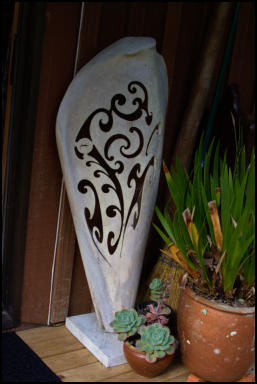


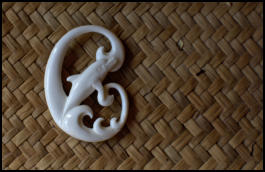







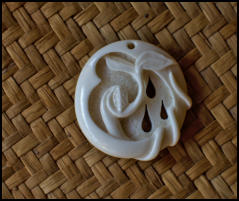
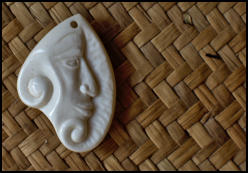
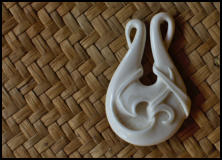
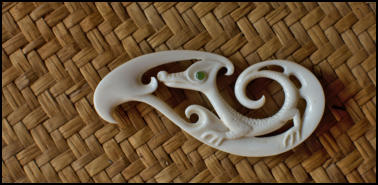







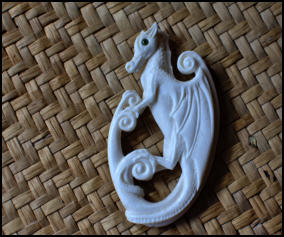



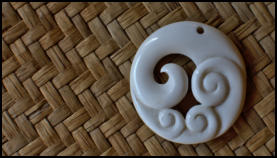
BONE CARVING TIPS
THE BONE: This day and age there is a scarcity of the New Zealand traditional bone for carving...... jawbone from the Sperm
Whale, and that at least is a pleasing thing with todays supplies being that from stranded whales only, dead ones I might add. It
is an interesting bone to carve, quite grainy really and not always useful for really fine work, however for most carvers that is
irrelevant, it has "mana".
Carvings these days are done out of beef bone and similar, the leg bones primarily, the older and bigger the beast the thicker
the bone. This is the easiest way I have found of preparing it:
•
Take your fresh leg bone remove the ends far enough down to avoid the honeycomb texture bone inside.
•
Extract the marrow.
•
Place the bones in a pot of water with a generous dollop of dishwashing liquid (to break down the fat).
•
Simmer gently until the meat scraps on the outside are cooked and remove easily.
•
Drain, cool and scrape clean, remove any honeycomb bone left inside, leave to dry, then cut to size.
What you are aiming for with this is to remove any fat and meat without destroying the "life" in the bone, and still have it come
up white. Most of the problems arise from fat getting into the structure of the bone so don't let it get there in the first
instance......... Bone that is worn a lot will eventually absorb body oils giving it the yellow translucent look, my view is that it's
better yours than of some cattle beast.
THE CARVING: At best I can only give a few suggestions and guidelines so this is how I go about it....
•
Bone in hand I draw my design on the bone as accurately as I can.
•
Then cut it out with a very fine bladed coping saw, you can get blades from jeweler supplies.
•
I support the bone on a small wooden extension out from my work bench this way I can hold the bone steady on both
sides of the cut.
The fine blades can break easily unless the the bone is well supported. To remove interior cutouts, drill a hole and thread the
blade through.
What you are aiming for is to remove as much bone as possible to save having to grind it off later, and give yourself a fairly
accurate form to carve to, so the more skillful at this point the easier it is later.
Now you have defined your shape it is simply a matter of shaping................ sounds easy doesn't it. Basically you remove the
stuff that obviously shouldn't be there, working all over the piece to retain a sense of form. You can use gravers, files, Dremels,
drills, grinding stones, whatever works for you. High speed rotary tools are the go these days and certainly speedy things.
When you have ground, carved or removed as much bone as possible then it is down to various grades of sandpaper, I usually
finish with 100 grit and found garnet paper was just fine. I cut it in to strips about 2cm wide which made it reasonably flexible
and you wasted little.
Final Polish: I used a cotton buff wheel and a stick of jewelers metal polish......... must be the white version otherwise it will
stain the bone.





























